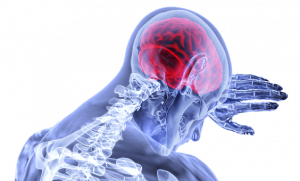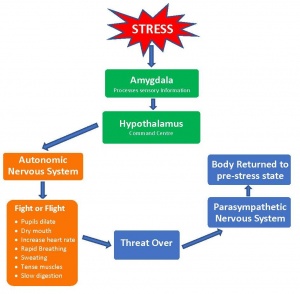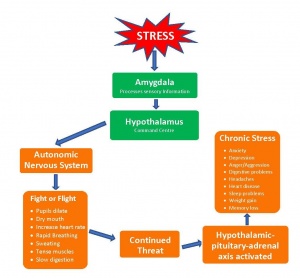Considering the Stress Pain Cycle in Assessment: Difference between revisions
Kim Jackson (talk | contribs) No edit summary |
Kim Jackson (talk | contribs) No edit summary |
||
| Line 15: | Line 15: | ||
==== Physiological Response to Stress ==== | ==== Physiological Response to Stress ==== | ||
When we are faced with a stressor messages that come from our senses are processed in the brain, this information is then sent to amygdala, (defintion). The first step in this process is for our bodies to determine the severity of the threat, based on our senses, perception and memories. If the threat is strong and our processing decides action is necessary then the hypothalamus is activated. The hypothalmus is the command centre of the brain and communicates with the rest of the body through the two branches of the autonomic system. The sympathetic nervous system, that stimulates the adrenal glands releasing adrenaline (epinephrine) and cortisol into the blood stream triggering physiological changes preparing us for action and the parasympathetic nervous system, that acts to slow down the response (diagram). However, if the stress chronic,repeated, ongoing or long-term, then the responses designed to protect us actually become detrimental to our health(diagram) | When we are faced with a stressor messages that come from our senses are processed in the brain, this information is then sent to amygdala, (defintion). The first step in this process is for our bodies to determine the severity of the threat, based on our senses, perception and memories. If the threat is strong and our processing decides action is necessary then the hypothalamus is activated. The hypothalmus is the command centre of the brain and communicates with the rest of the body through the two branches of the autonomic system. The sympathetic nervous system, that stimulates the adrenal glands releasing adrenaline (epinephrine) and cortisol into the blood stream triggering physiological changes preparing us for action and the parasympathetic nervous system, that acts to slow down the response (diagram). However, if the stress chronic,repeated, ongoing or long-term, then the responses designed to protect us actually become detrimental to our health(diagram) | ||
[[File:Stress response 1.jpg|left|frameless]][[File:Stress_response_2.jpg|right|frameless]]{{#ev:youtube | dErTZ-zj1dQ | 300<ref>Intro to Psychology. Two Pathways for Stress Response. Available from: https://www.youtube.com/watch?v=dErTZ-zj1dQ}} | [[File:Stress response 1.jpg|left|frameless|alt=Acute Stress - Physiological Response]][[File:Stress_response_2.jpg|right|frameless]]{{#ev:youtube | dErTZ-zj1dQ | 300<ref>Intro to Psychology. Two Pathways for Stress Response. Available from: https://www.youtube.com/watch?v=dErTZ-zj1dQ}} | ||
==== The Relationship between Chronic Pain and Stress ==== | ==== The Relationship between Chronic Pain and Stress ==== | ||
It has been established that chronic pain can contribute to stress and also stress can contribute to chronic pain. The burden of of a long-term illness or disability can put a lot of emotional and financial pressure on a person, the worry of not being able to work or feeling excluded from activities as well as feeling misunderstood can have a negative impact on the way a person sees their role within their family and society. Table 1 shows the link between chronic stress and pain. | It has been established that chronic pain can contribute to stress and also stress can contribute to chronic pain. The burden of of a long-term illness or disability can put a lot of emotional and financial pressure on a person, the worry of not being able to work or feeling excluded from activities as well as feeling misunderstood can have a negative impact on the way a person sees their role within their family and society. Table 1 shows the link between chronic stress and pain. | ||
Revision as of 00:39, 18 June 2018
Original Editor - Your name will be added here if you created the original content for this page.
Top Contributors - Kim Jackson, Admin, George Prudden, Claire Knott, Lucinda hampton and Jess Bell
Introduction[edit | edit source]
Physiotherapists are trained professionals who, on a daily basis, help clients deal with pain and movement dysfunction. As the profession has moved towards evidence based practice the way a client's therapy is delivered has also changed, we are moving away from didactic teaching and anecdotal practices, to provide the client with interventions that are based not only our clinical experiences but solid research[1]. This has led to to changing from the biomedical based approach to a more client centred biopsychosocial approach. This has been largely influenced by the recognition that emotional factors such as fear, anxiety and stress can delay and impede the recovery of those suffering from pain. Fear and anxiety may be personality traits but they can also be a byproduct of stress and stress has now been recognised as a factor in pain. It is well known that short term stress can be beneficial, especially in a crisis, but persistent or long term (chronic stress) can be the cause of pain. It has also been determined that stress can be one of the symptoms of chronic pain. In order to fully understand the shift in assessment and treatment approaches it is important to understand stress and also how people’s behaviour and fears affects not only their pain but also their perception and approach to pain and participation recovery.
What is Stress?[edit | edit source]
Stress is an emotional (and physiological) response to either a known or perceived threat and it can be categorised as either acute or chronic. Although just the mention of stress can have a negative connotation, it can also be seen as a positive and necessary process. Acute stress in the face of danger can actually prepare us for response and illicit a fight or flight response, acute stress that is repetitive or not released and chronic stress on the other hand can be negative and detrimental to our health and well-being. It is something until recently that did not receive a lot of attention but the World Health Organisation have recognised the need for strategies to be in place to help those suffering from various forms of stress [2] and have also recognised the increasing problem of stress in the work place, stating that it is becoming a worldwide epidemic (source). To better understand how this impacts physiotherapists it is important to understand not only the biological and physiological response to stress but also the relationship between chronic pain and stress and how it can influence individuals.
Physiological Response to Stress[edit | edit source]
When we are faced with a stressor messages that come from our senses are processed in the brain, this information is then sent to amygdala, (defintion). The first step in this process is for our bodies to determine the severity of the threat, based on our senses, perception and memories. If the threat is strong and our processing decides action is necessary then the hypothalamus is activated. The hypothalmus is the command centre of the brain and communicates with the rest of the body through the two branches of the autonomic system. The sympathetic nervous system, that stimulates the adrenal glands releasing adrenaline (epinephrine) and cortisol into the blood stream triggering physiological changes preparing us for action and the parasympathetic nervous system, that acts to slow down the response (diagram). However, if the stress chronic,repeated, ongoing or long-term, then the responses designed to protect us actually become detrimental to our health(diagram)
The Relationship between Chronic Pain and Stress[edit | edit source]
It has been established that chronic pain can contribute to stress and also stress can contribute to chronic pain. The burden of of a long-term illness or disability can put a lot of emotional and financial pressure on a person, the worry of not being able to work or feeling excluded from activities as well as feeling misunderstood can have a negative impact on the way a person sees their role within their family and society. Table 1 shows the link between chronic stress and pain.
The Importance of Recognising and Understanding Symptoms of Stress[edit | edit source]
How Stress Can Influence Our Behaviour, Attitude and Responses[edit | edit source]
BioMedical vs Biopsychosocial approaches to assessment and treatment[edit | edit source]
New Approaches to Assessment and Treatment[edit | edit source]
Barriers to Cognitive Functional Therapy[edit | edit source]
Resources[edit | edit source]
- bulleted list
- x
or
- numbered list
- x









